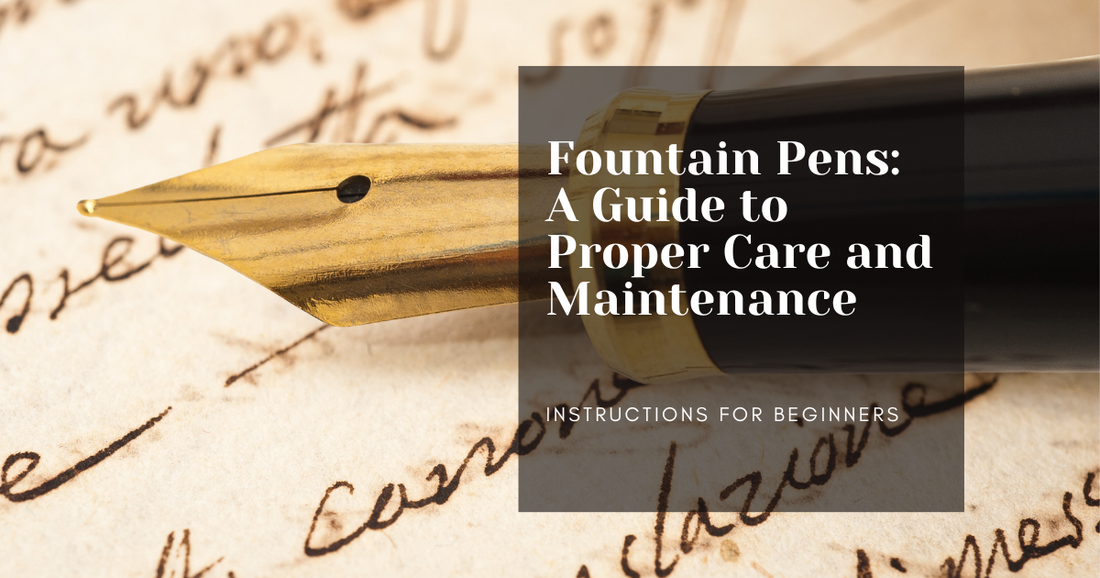
Fountain pens are a classic writing instrument that have been around for centuries. These pens are a great choice for those who love the feel of a traditional pen and enjoy the personal touch that comes with writing by hand. However, unlike ballpoint or rollerball pens, fountain pens require a bit more care and maintenance. In this guide, we will cover the basics of fountain pen care and maintenance so that you can enjoy your pen for years to come.
Cleaning Your Fountain Pen
Fountain pens should be cleaned regularly to prevent clogging and maintain the flow of ink. You can clean your pen by flushing it with water or a specialized pen cleaner. Here is a step-by-step guide on how to clean your fountain pen:
1. Remove the ink cartridge or converter from the pen.
2. Fill a small bowl with water.
3. Dip the nib and feed of the pen into the bowl and gently swirl it around for 10-15 seconds.
4. Empty the water from the bowl and refill it with fresh water. Repeat the process until the water runs clear.
5. Dry the pen thoroughly with a soft cloth.
Storing Your Fountain Pen
When not in use, it's important to store your fountain pen properly to prevent damage and ensure that it is ready to write the next time you need it. Here are some tips for storing your fountain pen:
1. Store your pen in a cool, dry place.
2. Avoid exposing your pen to extreme temperatures and humidity.
3. Store your pen with the cap on to prevent the nib from drying out.
4. Store your pen with the nib facing upwards to prevent ink from flowing into the cap.
Refilling Your Fountain Pen
When your fountain pen runs out of ink, it is time to refill it. There are two main options for refilling your pen: using an ink cartridge or using a bottled ink and a converter.
1. Ink Cartridges:
If your pen uses cartridges, simply remove the empty cartridge and replace it with a new one.
2. Bottled Ink and Converter:
If your pen uses a converter, simply fill the converter with the ink of your choice and screw it back into the pen.
Additional Tips
In addition to the basics of cleaning, storing, and refilling, there are a few other tips that can help you get the most out of your fountain pen.
1. Nib Adjustments:
If you notice that your fountain pen is skipping or the ink flow is too heavy, it may be necessary to adjust the nib. Some pens come with adjustable nibs that can be tuned for a smoother writing experience. If you are not comfortable making these adjustments, you can take your pen to a professional for help.
2. Proper Writing Techniques:
To avoid skipping and smudging, it is important to use proper writing techniques when using a fountain pen. Hold the pen at the correct angle, apply light pressure, and keep the pen moving to ensure a smooth flow of ink.
3. Use Good Quality Ink:
The type of ink you use can have a significant impact on the performance of your fountain pen. High-quality, non-waterproof inks are recommended as they are less likely to clog the pen.
4. Regular Maintenance:
Regular maintenance is key to keeping your fountain pen in top condition. This may include cleaning the pen, adjusting the nib, or changing the ink. Some fountain pens come with a manufacturer's warranty that covers any repairs or maintenance, so be sure to check the terms of your warranty before making any repairs.
5. Protect Your Nib:
The nib of a fountain pen is a delicate component that can be easily damaged if it is dropped or bumped. To avoid damage, store your pen with the cap on and be careful when handling the pen. If you need to clean the nib, handle it gently to avoid bending or breaking the tines.
6. Avoid Airtight Containers:
It is important to avoid storing your fountain pen in airtight containers as this can cause the ink to dry out and clog the pen. Instead, store your pen in a pen case or a desk drawer where it can get some air flow.
7. Use the Right Paper:
The type of paper you use can also have an impact on the performance of your fountain pen. Thick, porous paper can cause the ink to bleed and feather, while smooth, non-porous paper can make the ink appear pale and washed out. Experiment with different types of paper to find what works best with your pen and ink.
8. Proper Ink Level:
Keeping the ink level in your pen at the right level can also help prevent skipping and clogging. When filling the pen with bottled ink, make sure not to over-fill the converter or cartridge as this can cause the ink to overflow and make a mess.
9. Follow the Manufacturer's Recommendations:
Every fountain pen is different, so it is important to follow the manufacturer's recommendations when it comes to care and maintenance. If you have any questions or concerns, reach out to the manufacturer for guidance.
10. Keep a Backup Pen:
It's always a good idea to have a backup pen on hand, especially if you use your fountain pen frequently. Having a backup pen can help minimize the inconvenience of a pen running out of ink or experiencing a problem, so you can keep writing without interruption. Consider purchasing a second fountain pen or a rollerball or ballpoint pen as a backup.
Fountain pens are a wonderful writing instrument that require a little extra care and maintenance to keep them working properly. With the tips and guidelines outlined in this guide, you can ensure that your fountain pen will be a reliable and enjoyable writing tool for years to come.

